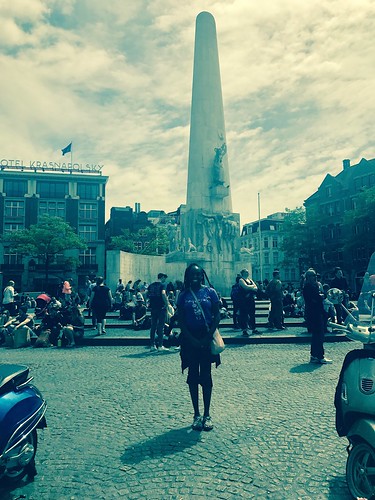Stepping into Amsterdam
By Faramola S.
June 28, 2017

When I first stepped out of Amsterdam Centraal, I was immediately struck by the variation of color that rode up and down the narrow, cobbled streets of the city on streams of bicycles. In other words, I was more than a little surprised at how much diversity made up the streets of Amsterdam. I won’t lie, I felt justifiably foolish to assume that Amsterdam, or better yet the Netherlands, was made up of a homogeneous, entirely white populace. Oh, how wrong I was, and I could only silently stifle a wave of my own embarrassment while rolling my heavy suitcase and, in a very tourist-like fashion, gaping at the many passing faces that formed an expansive spectrum of ethnicities that I have not seen anywhere else. However, even more than the embarrassment was a sense of calm and comfort that flooded my entire being at seeing so much diversity in this constantly bustling city. The sounds of varying accents and languages filled the air of Amsterdam and made it melodic and dynamic. I was also awed at the mix of antiquity and modernity of the city. I saw the antiquity of the city itself, in the old architecture of the churches and other landmark historical buildings that lined the streets of Amsterdam. I saw the modernity, however, in the people of Amsterdam. I saw so many young faces, riding these almost vintage bikes, dressed in modern and hip clothing, and casually smoking marijuana. I believe that the presence of Amsterdam’s youth added a sense of liberalism to an already progressive atmosphere. It was an interesting contrast to witness.
While touring the Netherlands as a study abroad student, I’ve learned that an entire semester in the classroom does not hold a candle to learning about a subject “in the field,” so to speak, by going to museums for even just a day. I’ve learned so much about the Holocaust and the history of genocide just by wandering about the National Holocaust Memorial, Jewish Cultural Museum, Amsterdam Museum and Anne Frank Museum. I haven’t only learn, but I’ve experienced. Of course, I could never truly understand what those millions of Jews went through when the Germans first invaded the Netherlands in 1940. I cannot experience even a fraction of the pain and agony that they felt as they were forced from their homes and transported to the Hollandsche Schouwburg theater, and from there, Westerbork, before being shipped off to the final destination: Auschwitz (or another concentration camp). I don’t believe anybody could truly understand the full extent of misery that many of these Dutch (and other migrant) Jews went through, but by going to these museums, walking through down the same streets that many of them used to journey down before the arrival of the Nazis, I got a sense of who they were and the imprint that they left on this vibrant city. While touring the Anne Frank Museum, learning about those two years of hiding in the annex with her family, and all that she’d written in her diary, I couldn’t help but wonder why they bothered hiding when they were caught by the Nazis anyway. I wondered if it had all been worth it. It was an intensive thought, especially when I came to this conclusion: Despite Anne and her family being caught by the Nazis and eventually being sent to their deaths, their life in the annex was worth it because, without it, without Anne’s narrative, her legacy would not have survived and, therefore, our honoring of her life would have been nothing. By learning about this young Jewish girl, we also catch a glimpse of the lives of many of the Jews who were attempting to survive during this time of crisis. Her life, and that of her sister Margot, might have ended abruptly, but her legacy? Her legacy has outgrown her life by what she left the world. She ensured that we never forget about her and the many who were murdered in Auschwitz and other concentration camps. It is not only Anne’s diary that is an important landmark left in this country, but there are memorials, traces of reminders of what the Jews experienced throughout the city. Amsterdam has been determined to remember those darker days so that there could be brighter ones in the future. By refusing to hide what has unfolded, this city is a vibrant one that is unafraid to expose its past imperfections, and that, in itself, has made it a fortress of strength.
About the blogger
Faramola S. is studying abroad on the Peace, Justice and the International Courts program in Amsterdam and The Hague, Netherlands.